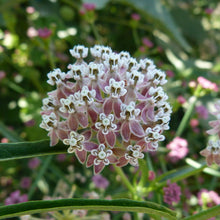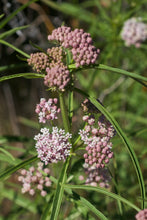Asclepias fascicularis
Milkweeds are universally adored by pollinators and are a nectar source and host plant for the iconic and imperiled Monarch Butterfly. Like its cousin, showy milkweed, this species has a bushy habit, spreads by rhizomes over time, and contains a milky sap that exudes from its tissues once they are broken. Narrowleaf milkweed is unique in that it has strap-like foliage up to six inches long, giving it a more delicate appearance and soft, pastel pink flower clusters that are lightly scented.
- Plant type/canopy layer: deciduous, perennial, herbaceous plant
- Size at maturity: 24-36", spreads laterally by rhizomes forming dense patches
- Light requirements: full sun, part sun/part shade
- Moisture requirements: dry to moist soil, prefers well-drained
- Bloom time: June - August
- Growth rate/ease: medium to slow growth rate, easy to grow
- Wildlife support: flowers attract and provide nectar to hummingbirds, adult butterflies, bees and other insect pollinators; overall plant attracts and supports beneficial insects and other pest eating insects and is a caterpillar host plant and larval food source for native butterflies and moths
- Native habitat/range: grows in a varied array of habitat types from moist to dry open, sunny places, grasslands and prairies, to open woodlands and forest openings. Portland Plant List - no.
- Special features & uses: important plant for pollinators, specifically butterflies and hummingbirds; deer resistant; landscape uses include pollinator gardens, meadowscapes, rock gardens, and erosion control
Gardening with Narrowleaf Milkweed: Narrowleaf milkweed will be a gorgeous addition to sunny pollinator gardens and other, open naturescaped areas of your property. It requires, and will flower best, in sunny to mostly sunny areas with dry to moist soils. It isn’t picky about soil type, provided they are fast-draining. Be sure to keep this plant moist while establishing, and then cut back supplemental water once established. It also is intolerant of any root disturbance once established. Like showy milkweed, narrowleaf milkweed needs plenty of light and warmth to come out of dormancy, and therefore, emerges late in the spring after many other flowers have already started.
Seed Sowing Instructions: Stratification is needed - but exact time is unknown. Literature states 0-160 days. 6-8 weeks may be adequate.
- Planting depth: 1/4” - just to cover
- Seeding rate: broadcast approx 20 seeds/sq ft, add 3-5 seeds per small pot or 3-5 seeds per spot (in situ)
- Each seed packet contains approx 45 seeds
Photo Credit 1: "Asclepias fascicularis (Narrow leaf milkweed) CA native" by PlantRight1 is licensed under CC BY 2.0.
Photo Credit 1: "Asclepias fascicularis" by Eric Hunt is licensed under CC BY-SA 3.0.




